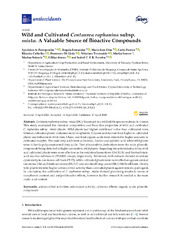Приказ основних података о документу
Wild and Cultivated Centaurea raphanina subsp. mixta: A Valuable Source of Bioactive Compounds
| dc.creator | Petropoulos, Spyridon A. | |
| dc.creator | Fernandes, Ângela | |
| dc.creator | Dias, Maria Ines | |
| dc.creator | Pereira, Carla | |
| dc.creator | Calhelha, Ricardo | |
| dc.creator | Di Gioia, Francesco | |
| dc.creator | Tzortzakis, Nikolaos | |
| dc.creator | Ivanov, Marija | |
| dc.creator | Soković, Marina | |
| dc.creator | Barros, Lillian | |
| dc.creator | Ferreira, Isabel C. F. R. | |
| dc.date.accessioned | 2020-05-08T10:55:04Z | |
| dc.date.available | 2020-05-08T10:55:04Z | |
| dc.date.issued | 2020 | |
| dc.identifier.issn | 2076-3921 | |
| dc.identifier.uri | https://www.mdpi.com/2076-3921/9/4/314 | |
| dc.identifier.uri | https://radar.ibiss.bg.ac.rs/handle/123456789/3664 | |
| dc.description.abstract | Centaurea raphanina subsp. mixta (DC.) Runemark is a wild edible species endemic to Greece. This study evaluated the chemical composition and bioactive properties of wild and cultivated C. raphanina subsp. mixta plants. Wild plants had higher nutritional value than cultivated ones, whereas cultivated plants contained more tocopherols. Glucose and sucrose were higher in cultivated plants and trehalose in wild ones. Oxalic and total organic acids were detected in higher amounts in cultivated samples. The main fatty acids were α-linolenic, linoleic and palmitic acid, while wild plants were richer in polyunsaturated fatty acids. Two pinocembrin derivatives were the main phenolic compounds being detected in higher amounts in wild plants. Regarding the antioxidant activity, wild and cultivated plants were more effective in the oxidative haemolysis (OxHLIA) and thiobarbituric acid reactive substances (TBARS) assays, respectively. Moreover, both extracts showed moderate cytotoxicity in non-tumor cell lines (PLP2), while cultivated plants were more effective against cervical carcinoma (HeLa), breast carcinoma (MCF-7) and non-small lung cancer (NCI-H460) cell lines. Finally, wild plants showed higher antimicrobial activity than cultivated plants against specific pathogens. In conclusion, the cultivation of C. raphanina subsp. mixta showed promising results in terms of tocopherols content and antiproliferative effects, however further research is needed to decrease oxalic acid content. | en |
| dc.publisher | MDPI AG | |
| dc.relation | info:eu-repo/grantAgreement/MESTD/inst-2020/200007/RS// | |
| dc.relation | National Institute of Food and Agriculture (04723,1020664) | |
| dc.relation | Foundation for Science and Technology | |
| dc.rights | openAccess | |
| dc.rights.uri | https://creativecommons.org/licenses/by/4.0/ | |
| dc.source | Antioxidants | |
| dc.subject | Antimicrobial activities | |
| dc.subject | Antioxidant activity | |
| dc.subject | Cytotoxic effects | |
| dc.subject | Organic acids | |
| dc.subject | Phenolic compounds | |
| dc.title | Wild and Cultivated Centaurea raphanina subsp. mixta: A Valuable Source of Bioactive Compounds | en |
| dc.type | article | en |
| dc.rights.license | BY | |
| dcterms.abstract | Цалхелха, Рицардо; Иванов, Марија; Ди Гиоиа, Францесцо; Тзортзакис, Николаос; Соковић, Марина; Баррос, Лиллиан; Ферреира, Исабел Ц. Ф. Р.; Петропоулос, Спyридон A.; Фернандес, Âнгела; Диас, Мариа Инес; Переира, Царла; | |
| dc.rights.holder | © 2020 by the authors. Licensee MDPI, Basel, Switzerland. | |
| dc.citation.issue | 4 | |
| dc.citation.volume | 9 | |
| dc.identifier.doi | 10.3390/antiox9040314 | |
| dc.identifier.pmid | 32326524 | |
| dc.identifier.scopus | 2-s2.0-85083863602 | |
| dc.identifier.wos | 000536961200044 | |
| dc.citation.apa | Petropoulos, S. A., Fernandes, Â., Dias, M. I., Pereira, C., Calhelha, R., Di Gioia, F., et al. (2020). Wild and Cultivated Centaurea raphanina subsp. mixta: A Valuable Source of Bioactive Compounds. Antioxidants, 9(4), 314. | |
| dc.citation.vancouver | Petropoulos SA, Fernandes Â, Dias MI, Pereira C, Calhelha R, Di Gioia F, Tzortzakis N, Ivanov M, Sokovic M, Barros L, Ferreira ICFR. Wild and Cultivated Centaurea raphanina subsp. mixta: A Valuable Source of Bioactive Compounds. Antioxidants. 2020;9(4):314. | |
| dc.citation.spage | 314 | |
| dc.type.version | publishedVersion | |
| dc.identifier.fulltext | https://radar.ibiss.bg.ac.rs/bitstream/id/6156/Antioxidants_2020_9_4_314.pdf | |
| dc.citation.rank | aM21 |

